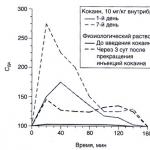To ensure that care in the open ground is not burdensome, you should carefully consider the choice suitable place. A well-lit area, at least slightly protected from the wind, is needed. Do not plant the plant near trees or shrubs. This can have a detrimental effect on the availability of nutrients to the plant's roots. Besides. you will have to cultivate the soil to a fairly large depth, and you may accidentally damage the roots of neighboring plants.
The area can be flat, a slight slope is allowed, which will facilitate the rapid removal of excess moisture. Plants planted in lowlands may die due to a sufficiently high level groundwater and excessive soil moisture. Groundwater should be at a depth of more than 70 cm. If the level is critical, you should take care of a good drainage layer when planting the plant, you can also try to slightly raise the flower bed by adding a little soil. It will be quite easy to care for in the garden when planted in light sandy soil, well enriched with humus. pH values are required at a level exceeding 6.5.
The soil should breathe well, and the recommended layer fertile soil, should be at least half a meter. A good mixture can be prepared from four components. Required 40% turf land, 40% well-rotted manure, 10% river sand and 10% ordinary leaf humus.

Preparing for winter
It must be said that caring for it at home is much easier, since it does not involve careful preparation of the plant for wintering. Even before the onset of frosty nights, you should take care of shelter for the hyacinth. You can use sawdust that has already been rotted, dried leaves, small trimmings of thin branches; straw and pine needles work well. All these available materials must be laid out in a thick layer, approximately 25 cm. The coating should extend beyond the planting limits to this distance. After snow falls, it is recommended to use it as additional protection. After the snow melts, carefully open the plant over several stages. Be very careful not to snag the fragile shoots. They appear soon after the snow melts.
Top dressing
After the snow melts and the winter protective layer is eliminated, you need to feed the plant. Must be applied nitrogen fertilizers, to stimulate flower stalks. The next feeding will be required during the budding period. During the second feeding, phosphorus will be required.
Proper care of hyacinth after flowering involves feeding after flowering. This is extremely important to do so that the bulb can replenish nutrients, they will be used already in next year, during the formation of peduncles.
Watering is required with each feeding. This will help transfer nutrients to the lower layers of the soil and at the same time rinse well top layer. The liquid should not get on the leaves or flowers. Do not forget to loosen the soil, but do it very carefully so as not to damage the very fragile plant.

Bulb digging schedule
If the bulbs are left in the ground, you may encounter disease in the future. To avoid this risk, you can dig up the bulbs. This should be done during the period of strong yellowing of the leaves. The dug up bulbs must be kept in a dark, normally ventilated room, with a temperature of 18 ° C for ten days. During this time, the bulbs dry out well; they must be cleaned of any remaining soil and roots. We place the bulbs in cardboard boxes, preferably in one layer. After this, the bulbs need to be kept for about a couple of months, at a temperature of about 24 ° C, maybe a little higher. After this period, it is necessary to change the storage mode and move the bulbs to a cool room, with high level humidity. The room temperature is desirable at 16° C. They need to be kept in this mode for a month. Then, the bulbs must be kept for several days in temperature conditions, close to natural. This is already done, immediately before landing. Let's calculate the approximate time required to store the bulbs and get a certain time frame for the work. It turns out that the bulbs should be dug up in late June in order to plant them in early October.

Home care
Growing a plant in a pot is easy to do at home. Pay attention to the quality of the bulbs you purchase. There should not be any marks on them mechanical damage. The bulb should be dense, without the slightest trace of rot. In diameter, it should exceed 5 cm. Before planting in the soil, the air temperature should be approximately 18 ° C. As already mentioned, the soil should be light, with good water permeability. It is recommended to apply a small layer of compost to the top of the pot. During the planting process, it is necessary to ensure that part of the bulb protrudes above the soil by about 1-2 cm. Feeding is necessary only during the flowering period; you can get by with standard mineral fertilizers. For hyacinth, the optimal location is near a window, with good, fairly bright light. The air humidity for the plant is quite moderate. Watering in winter and spring should be done regularly and little by little, avoiding the soil from drying out. When hyacinth goes into a dormant period, watering should be greatly limited to a minimum. After wilting, watering must be stopped. We need to start trimming the leaves and peduncles. The plant should be placed in a dark, cool place, with increased level humidity. If after the end of summer you notice the appearance of bulbs, they should be transplanted into a separate container. Hyacinth at home begins to grow after the appearance of small sprouts, about 2 cm. During this period, you should move the pot closer to the light, but in a cool place, then you will achieve full flowering. The appearance of buds serves as a signal to move the hyacinth to a warmer place. The temperature can be 25°C, or higher. Protect it during this period from drafts and from excessive heat emanating from heating radiators. Water very carefully, make sure that water does not get on the bulb and buds, and protect the axils of the leaves. The soil should be slightly moist during the flowering period; do not overwater the plant, otherwise the bulb will begin to rot. If possible, provide the flower with additional lighting in the evening.
Remember that the plant is not demanding and forgives small mistakes during the care process. It will bloom, although not as profusely with minor misses. But major mistakes, such as violation of the watering schedule and insufficient attention to the composition of the soil and timely fertilization of the plant, can destroy it.


Hyacinth is one of the most popular bulbous plants for home forcing, along with some varieties of tulips, daffodils, crocuses, and muscari. In a dormant state, bulbous and corm plants form the organs of future plants in the bulbs. With traditional cultivation in the garden, flowering occurs early spring. When forcing hyacinths at home, the natural rhythms of the plant can be changed and flowering can be achieved at the desired time, for example, for the holidays.
To achieve this result, you need to follow specially developed technologies: regulate temperature and light. As a result, the plant is brought out of dormancy and delights with its flowers. But in order for hyacinths to bloom abundantly, and for the plant and bulb to remain healthy, it is necessary to adhere to several simple requirements as strictly as possible.
Conditions for forcing hyacinths at home
Decide by what time you want to receive blooming hyacinths. By the New Year (early forcing), January-February (mid-early forcing), March-April (late forcing). The period of forcing hyacinths from planting to flowering takes an average of 2.5 months.
It is necessary to have a cold, dark place where the hyacinth bulbs will initially be placed (ideally a cellar, but a refrigerator will do), and a cool, lit place where the hyacinth flowers that have begun to grow are placed at the second stage. Plants with blooming flowers can grow at room temperature (but it should not be too high, no higher than 18-20C) and good lighting. 
For home forcing of hyacinths, choose a larger bulb, with a diameter of more than 5 cm. This will serve as a guarantee successful growing And lush flowering. For forcing at home, bulbous plants are usually specially prepared. Therefore, buy bulbs from trusted places - garden centers, specialized stores. The bulb should be healthy, dense, without damage, with outer scales. 
Choose a suitable container for forcing hyacinths. It can be any boxes, wide pots, bowls, always with a drainage hole. Prepare soil mixture(any nutritious soil mixture with a neutral reaction), sand, drainage. Now you can proceed directly to planting your favorite flowers.
Stages of forcing hyacinths
1. Landing
Place a thin layer of drainage on the bottom of the pot or box and sprinkle it with sand; then fill with soil so that the tops of the bulbs rise about 2-3 cm above the soil surface. 
Plant the bulbs in the soil. The distance between the bulbs when forcing hyacinths should be about 2.5 cm. They should sit closely, but not touch each other or the walls of the bowl. This distance is much shorter than with traditional garden planting. Thanks to this location, flowering plants look more impressive. Punch the soil around the bulbs to make it more compact, then water the planted flowers. Sprinkle with a layer of sand 0.5-1 cm thick. This is necessary to avoid rotting of the bulbs during forcing.
Place the container with the planted hyacinth in a plastic bag and be sure to make a hole for ventilation. You can cover the top with another pot.
2. Care after landing 
Place the flower prepared in this way in a cool, dark place (refrigerator). At a temperature of 5-7 degrees at this stage of forcing hyacinths, the plant takes root, then the first shoots appear. 
The placement period under such conditions is 6-10 weeks. From time to time, check if the soil in the bowl is dry.
3. Care during growth period
After 10-12 weeks, when green shoots of 2-2.5 cm (hyacinth leaves) appear, move the bowls to a cool, shaded room with a temperature of 10-12 C. First, mark in a shaded place, after a few days, move closer to the window. 
The bulbs will begin to actively throw out leaves, and in a few weeks buds will appear. Now you can move the hyacinth to its intended place. It should be well lit (but not exposed to direct sun rays), free from drafts, away from heating devices. Air temperature – 15-20 C. The earth should be constantly moist. 
Rotate the bowl from time to time to ensure the plants grow evenly. If necessary, install supports. For lush, long-lasting flowering, fertilizing with liquid fertilizer is necessary. 
4. Care after flowering
After flowering has ended and the leaves have died, the bulbs can be dug out of the pot, dried and stored in a cool, dry room until autumn, then planted in autumn. open ground. Restoration of the hyacinth bulb for the next forcing will occur in 1-2 years. 
Difficulties in forcing hyacinths
yellow leaves
Most probable cause- drafts. Other reasons may be improper watering and insufficient lighting.
Buds do not open
Improper watering can cause buds to fall off; the same result can be caused by water getting on the buds due to careless watering.
Non-simultaneous flowering of bulbs
The most likely reason is initially different size or the strength of the bulbs. If the bulbs were selected according to size, then the reason may be that the bowl was not turned.
Long limp leaves
Plants have been kept in the dark for too long. Another reason may be insufficient light during the flowering period.
Slow growth
The dormant period is not long enough: you can move the plant to a bright room only when the sprouts reach 2.5 - 5 cm in height. Another reason is insufficient watering.
Lack of flowers
Perhaps the bulbs were not large enough. Keeping the container at too high a temperature can lead to the same result. high temperature or too hasty transfer to the bright sun. Flowering can be inhibited by insufficient watering.
Deformed flowers
Temperature too high during rest period (should not exceed 5-7 C)
Decaying flowers
Overwatering. In cool conditions, a container without drainage holes will quickly become waterlogged. Keep this in mind and pour excess moisture over the edge of the bowl.
I told on the blog how am I I let hyacinths bloom in winter, .e. forcing gia bulbs cints. Such forcing can be done in two ways: in water and in soil. This time I'm showing you, my readers, forcing hyacinths in cups of water.
First, from September-October, the selected bulbs must be cooled in dark place with a temperature of +2...+6 C for 3-4 months. Then the bulbs should be placed on the neck of a tall glass of water. Thus, already in February, hyacinths appeared roots, leaves and the growth of a green stem and peduncle began.
The roots of the bulbs grew and filled the glass. But as you have already noticed, one hyacinth gave very small roots, although it grew a fairly tall stem.
When I select bulbs for cooling, after 2 months some of them always disappear, so the color of the remaining hyacinths is always a surprise for me. This year, the pink hyacinth was the first to bloom, followed by the white ones, and their aroma reminded us that spring is coming.

It rained in the garden then it snowed and the garden looked beautiful the snow was white and very fluffy. He shaded the branches beautifully Niwaki willows (bonsai). I took a shovel, cleaned the paths in the garden, and it immediately became tidy.

Returning to the city from the garden, it is nice to see another hyacinth in bloom. And next in line are already sprouting tulips, muscari and pushkinia. But about them - in the following stories.
Water hyacinth is a tropical perennial, which must be planted in water in the summer. Counts good cleaner reservoirs. The plant is capricious - it requires stable temperatures and constant lighting. Let's look at how to preserve water hyacinth in our latitudes in winter.
Hyacinth is an aquatic floating perennial plant native to the United States. It is otherwise called “Eichornia”. It is most often found in the wetlands of the Amazon. But now water hyacinth is distributed throughout the world. The plant mainly grows in the tropics, on the surface of bodies of water - rivers, lakes and ponds. In addition, it can even be grown in an aquarium and in decorative ponds.
When favorable climatic conditions hyacinth grows very quickly. This interferes with navigation, which is why the plant is often called water plague.
Hyacinth has swollen petioles that hold the plant afloat in the water. These petioles contain air and consist entirely of tissue with a honeycomb structure. They calmly maintain a lush emerald rosette, from the center of which flower stalks extend. The leaves of the plant are oval, dense and wrinkled. One flower can have up to 10 leaves. Root system fibrous and can reach up to 0.5 m in length. The rhizome of water hyacinth has unique property: it is able to purify water from phosphates, nitrates, heavy metals, phenols and other harmful impurities.
Flowering lasts throughout the summer, with each flower blooming for only 2 days. However, due to their large number, flowering seems long and abundant. Hyacinths bloom especially beautifully and brightly in non-rainy and warm weather.
The peduncle, after it has bloomed, goes under water. If the summer turns out to be cold, then a huge cap of emerald dense foliage appears above the water surface. Due to the dense vegetation layer, the oxygen regime of water bodies deteriorates. This could lead to the death of others aquatic plants, the reservoir itself becomes very bad smell. This phenomenon is usually observed in the homeland of water hyacinth.
Planting and caring for Eichornia
When planting a flower in a pond, you need to take into account that the water must be fortified and contain large number organic matter. Gardeners advise adding humus, river silt, compost, mullein and purchased complex fertilizers to the water. The active growth of rosettes depends on the amount of micronutrients.
Planting should be done in late spring - early summer, when the temperature is stable. An open, shallow pond with forced aeration or a dynamic natural one with water movement is ideal for planting. Eichornia can grow in bodies of water of any depth. If the depth is less than 50 cm, the plant will take root in shallow water or muddy soil. And if the depth is greater, then the flower will simply float.
The plant does not require special care. From time to time you need to cut off the old black petioles of the leaves. They easily break off from the mother flower.
Active growth begins at a temperature of 25-27 degrees. Flowering begins at temperatures above 28 degrees. This is the climate in Asia and the USA. Of course, in the central and northern parts of Russia it is difficult to achieve full flowering. But nevertheless, water hyacinth grows well in the south of the Russian Federation, Ukraine and Belarus. The closer to the south the plant is, the more abundantly it blooms.

The flower needs more than 14 hours of daylight. If there is a shortage sunlight the plant begins to wither and shed its leaves. If there is a lack of lighting, then the plant needs to be illuminated artificially. To do this, you can use fluorescent lamps.
Flower reproduction occurs surprisingly quickly. The procedure is a little reminiscent of the propagation of strawberries - daughter shoots appear in the hyacinth. In a month, the mother plant produces more than 100 new specimens.
The increase in mass in water hyacinth begins with a decrease daylight hours. In addition, the flower can reproduce by seeds. However, complete seed ripening occurs at a stable temperature above 36 degrees. After flowering, the fruits and seeds rupture, after which they fall into the water. With a lack of heat they rot, but at high temperatures they begin to grow very strongly.
When growing in our latitudes, it is very important to know how to preserve water hyacinth in winter. Let's consider at the moment in more detail.
Overwintering water hyacinth
When the temperature drops below 10 degrees, the plant must be brought indoors. More precisely, the future is entered planting material. The main goal is to keep the hyacinth alive for reproduction next summer.
Only young shoots should be taken for storage, the diameter of which is about 10 cm and the roots reach no more than 10 cm in length.
Known methods for storing water hyacinth are overwintering in:
- aquarium;
- sand;
- three-liter jar.
Overwintering in an aquarium
This is not as labor-intensive a process as it might seem at first glance. When choosing this method, you need to take into account some nuances. These include:
- Collect water from the same reservoir where the eichornia grew. This is the most best option. If this is not possible, take the settled one. Prepare water from the reservoir for the whole winter in advance.
- Place mud from the hyacinth's native pond at the bottom of the aquarium.
- The water must contain nutrients for the flower. You can add special fertilizers for aquarium plants.
- Regular room temperature is suitable for storage.
- It is advisable to place the aquarium on the windowsill so that there is the necessary lighting. In the evening, the plant can be additionally illuminated using a fluorescent lamp.
- To prevent leaf rotting, plant hyacinth on a foam float so that the leaves do not touch the water.

Storage in sludge
- Take a deep pot and fill it with silt from the bottom of the pond.
- Pour some water in there. Keep in mind that the water level in the pot should be at least 3-5 cm.
- Place the pot on a regular windowsill.
In this case, there is no need to add additional lighting. You just need to monitor the water level.
Storage in sand
Take any transparent pot and fill it with sand. In winter, it is necessary to constantly maintain humidity, otherwise the hyacinth will die. No special conditions are required for care: room temperature, additional lighting no need.
Overwintering in a jar
Hyacinth can easily overwinter in an ordinary three-liter jar. For successful storage, follow these recommendations:
- Fill a clean jar one-third full with water from your native pond.
- Place the shoots there and close tightly with a plastic lid.
- The jar should be placed on the north window. Room temperature will do. No additional lighting is needed.

By spring the water will become dark brown color. There is no need to be afraid of this, this is a completely normal phenomenon. The bulk of the roots will fall off, most of the leaves will die, but the plant itself will survive. After planting in a pond, leaves and roots will grow quickly.
Water hyacinth is a flower of stunning beauty. It is unpretentious in care, but quite demanding in terms of temperature and lighting. Particular attention should be paid to caring for the plant in winter period. There are many ways to preserve a flower for further propagation.

















